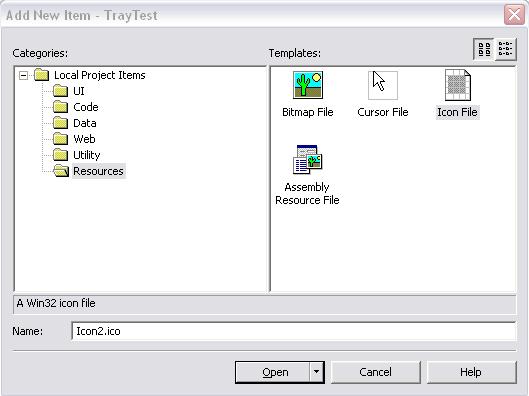Introduction
As MFC/SDK programmers move into .NET, what surprises them
most is the fact that everything is now so much more easier then ever before.
Christian Graus was complaining that it was too easy and that the abominable
allowance of gotos annoyed him. He might have a point there, but making coding
easy is not such a bad thing after all. It's funny when you think of all the
effort Chris Maunder and others put into those MFC & SDK tray icon classes
that are ever so popular with copy/paste programmers. I dedicate this article
to Chris M and others involved in the brilliant tray icon class project over
the last few years.
Adding the icon to your project
Ctrl-Shift-A will bring up the Add-New-Item dialog box.
Select Icon File from the list of available templates. If the list is too
populated to your liking select Resources from the tree control on the
left. This will bring up a smaller list on the right and it will be easier for
you to select Icon File. Now click open. You'll end up with the VS.NET
icon editor. You may now create your icon here or copy/paste an icon from
elsewhere.

Now right click on this icon from Solution Explorer. Take
properties. And change the Build Action property to Embedded Resource. This
will instruct the compiler to embed this icon along with your EXE file, thus
saving you the annoyance of having to distribute the icon with your EXE.

Adding the NotifyIcon member to your form
Okay. Now that we have our icon ready we need to add it to
our form class.
private NotifyIcon m_notifyicon;
Alright, so we have added a NotifyIcon member. Now let's
initialize it and set some default properties. This should be done from the
form object's constructor.
m_notifyicon = new NotifyIcon();
m_notifyicon.Text = "Hello, what's cooking?";
m_notifyicon.Visible = true;
m_notifyicon.Icon = new Icon(GetType(),"Icon1.ico");
Alright, now compile and run your program. You'll see the
icon in your tray. That was rather simple, huh? But usually people like to add
a context menu to their tray icons. A tray icon simply sitting there is not
very useful.
Adding a context menu to the tray icon
The first thing we need to do is to add a ContextMenu
member to our form.
private ContextMenu m_menu;
Now we need to initialize it and add some menu items.
m_menu = new ContextMenu();
m_menu.MenuItems.Add(0,
new MenuItem("Show",new System.EventHandler(Show_Click)));
m_menu.MenuItems.Add(1,
new MenuItem("Hide",new System.EventHandler(Hide_Click)));
m_menu.MenuItems.Add(2,
new MenuItem("Exit",new System.EventHandler(Exit_Click)));
We have added three menu items and have also associated
click event handlers for each of those menu items. I could have created an
array of MenuItem objects but that's not really needed here.
Now we need to associate this ContextMenu with our tray
icon. So we do this.
m_notifyicon.ContextMenu = m_menu;
Now let's fill up those event handlers.
protected void Exit_Click(Object sender, System.EventArgs e)
{
Close();
}
protected void Hide_Click(Object sender, System.EventArgs e)
{
Hide();
}
protected void Show_Click(Object sender, System.EventArgs e)
{
Show();
}
Okay. Compile and run it. Now right clicking on the tray
icon brings up the context menu. You can hide and show the form window using
the two menu options. And the "Exit" option will exit the application.
A small problem
Now you'll notice a slight annoyance. The tray icon does
not vanish when you exit the program. But when you move the mouse over the tray
the icon vanishes. So, what do we do to avoid that? Again as with everything
else with this whole .NET thing, it's as easy as 1,2,3. Override your form
object's Dispose function and put the following lines of code into it.
protected override void Dispose( bool disposing )
{
if( disposing )
{
this.m_notifyicon.Dispose();
}
base.Dispose( disposing );
}
Full Source Listing
using System;
using System.Drawing;
using System.Windows.Forms;
using System.Data;
namespace TrayTest
{
public class Form1 : System.Windows.Forms.Form
{
private NotifyIcon m_notifyicon;
private ContextMenu m_menu;
public Form1()
{
Text = "TrayIcon test program";
m_menu = new ContextMenu();
m_menu.MenuItems.Add(0,
new MenuItem("Show",new System.EventHandler(Show_Click)));
m_menu.MenuItems.Add(1,
new MenuItem("Hide",new System.EventHandler(Hide_Click)));
m_menu.MenuItems.Add(2,
new MenuItem("Exit",new System.EventHandler(Exit_Click)));
m_notifyicon = new NotifyIcon();
m_notifyicon.Text = "Right click for context menu";
m_notifyicon.Visible = true;
m_notifyicon.Icon = new Icon(GetType(),"Icon1.ico");
m_notifyicon.ContextMenu = m_menu;
}
protected void Exit_Click(Object sender, System.EventArgs e)
{
Close();
}
protected void Hide_Click(Object sender, System.EventArgs e)
{
Hide();
}
protected void Show_Click(Object sender, System.EventArgs e)
{
Show();
}
protected override void Dispose( bool disposing )
{
if( disposing )
{
this.m_notifyicon.Dispose();
}
base.Dispose( disposing );
}
[STAThread]
static void Main()
{
Application.Run(new Form1());
}
}
}
Conclusion
I would like to thank James Johnson for his valuable tips
while I was struggling with embedding icons into my exe. Also a special thanks
to Colin for keeping me cheered up with Bobs while I was burying myself in
despair after my bad experiences with the new CD writer.
 General
General  News
News  Suggestion
Suggestion  Question
Question  Bug
Bug  Answer
Answer  Joke
Joke  Praise
Praise  Rant
Rant  Admin
Admin 










